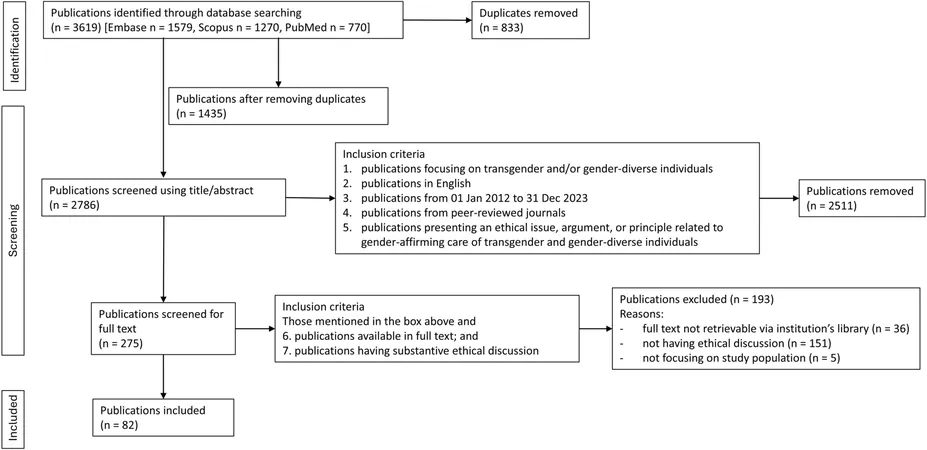
Navigating the Ethics of Gender-Affirming Care: A Scoping Review
2025-04-30
Author: Rajesh
Unpacking the Rise in Gender-Affirming Care Research
A recent scoping review highlights a burgeoning interest in the ethical landscape surrounding gender-affirming care for transgender and gender-diverse individuals, with 82 publications examined, 76% of which emerged after 2019. This growth reflects a significant shift in the healthcare discourse surrounding gender identity, predominantly authored by United States scholars, followed by contributors from the UK, Canada, and Australia.
Key Ethical Themes Identified
The review unearthed five prominent ethical themes regarding gender-affirming care: the decision-making process, guidelines for care, the handling of health data, funding issues, and fertility preservation services. A striking 65% of the literature focused on ethical considerations for children and adolescents, raising pivotal questions about their autonomy in medical decisions.
Diving into Decision-Making: Who Gets to Decide?
The debate over who should make medical decisions—minors or parents—rages on, especially regarding gender-affirming treatments. Proponents argue that many minors can competently make informed choices about their bodies, drawing parallels to other medical contexts, such as consent for contraceptive methods. They contend that denying minors this agency undermines their experiences and understanding of their identities.
Conversely, critics highlight concerns about minors’ cognitive maturity and potential impulsivity, suggesting that parents or guardians should guide such important decisions. They worry about the social pressures and complexities minors face in acknowledging their gender identity and the substantial implications of irreversible medical interventions.
Exploring Ethical Principles at Play
The review’s structured format offered a balanced view, presenting arguments both for and against various ethical positions. For example, discussions surrounding the benefits of gender-affirming care included the idea that interventions like puberty blockers could allow youth to explore their identities without the distress of unwanted physical changes while maintaining possibilities for future treatment decisions.
Guidelines for Gender-Affirming Care: A Battle of Frameworks
The discussion also contrasts the WPATH guidelines—which mandate mental health assessments for diagnoses—against a more liberal informed consent model. Advocates for WPATH argue that rigorous assessments safeguard against irreversible interventions for those who may not truly identify as transgender, ensuring a careful approach to care.
Critics of the WPATH approach argue it can pathologize gender diversity and create barriers for those seeking timely assistance. They call for a more self-determined approach to affirming identities without unnecessary delays.
Funding Controversies: Cosmetic or Medical?
Another heated topic involves whether gender-affirming procedures should be funded as medically necessary treatments rather than cosmetic interventions. Supporters assert these procedures are vital for mental well-being, paralleling funding for other medically justified surgeries like breast reconstructions. Critics question the weight of funding gender-affirming care amidst broader healthcare resource allocations.
The Future of Fertility Preservation: Complex Considerations
The ethical dialogue extends to fertility preservation services for transgender youth, advocating for them as a means of ensuring future reproductive choices. Conversely, challenges around the safety and long-term consequences of these procedures remain a significant point of contention.
Concluding Thoughts
This scoping review vividly illustrates the complexities surrounding gender-affirming care, encompassing ethical considerations that resonate deep within the fabric of healthcare. As discussions evolve, the need to balance autonomy, safety, and accessibility will remain paramount, aiming for a pathway that is just and responsive to the diverse needs of transgender and gender-diverse individuals.



 Brasil (PT)
Brasil (PT)
 Canada (EN)
Canada (EN)
 Chile (ES)
Chile (ES)
 Česko (CS)
Česko (CS)
 대한민국 (KO)
대한민국 (KO)
 España (ES)
España (ES)
 France (FR)
France (FR)
 Hong Kong (EN)
Hong Kong (EN)
 Italia (IT)
Italia (IT)
 日本 (JA)
日本 (JA)
 Magyarország (HU)
Magyarország (HU)
 Norge (NO)
Norge (NO)
 Polska (PL)
Polska (PL)
 Schweiz (DE)
Schweiz (DE)
 Singapore (EN)
Singapore (EN)
 Sverige (SV)
Sverige (SV)
 Suomi (FI)
Suomi (FI)
 Türkiye (TR)
Türkiye (TR)
 الإمارات العربية المتحدة (AR)
الإمارات العربية المتحدة (AR)